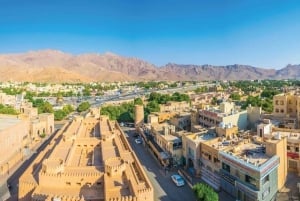
Muscat: Full-Day Nizwa Tour with Audio Guiding
195 ReviewsExplore the ancient city of Nizwa full of natural beauty, interesting culture, and rich history.
The exhibits range from real mammals, birds, reptiles and insects, preserved in life-like settings, to displays of colorful shells. The Museum also includes samples of fossils that are found in different areas of the Sultanate.
An interesting explanation is given of animals and plants behavior, information about their life pattern and their ability to survive in an arid climate. The exhibits gain more vitality through colorful photographs which were not displayed before.
The Whale Hall
In this hall visitors can identify different species of whales, dolphins and porpoises with an interesting explanation of the life of these extraordinary creatures, their breeding and search for food. Also they can identify the sounds of some of them.
Oman through Time
Outside the Museum is Oman’s oldest tree – 260 million years old. The second and third gallery explain the geological history of Oman since life started on earth more than 570 millions years ago and till present day, supported by real samples of fossils.
Oman – Land of Contrasts
In the first gallery of the Museum the visitors can see a map showing the general features of the Sultanate supported by magnificent satellite photographs of the country.
Following this are six separated displays showing the major natural features which distinguishes six Omani regions: Musandam, Northern mountains, Al-Batinah, Interior, Dhofar mountains and Omani Islands. Each of these displays includes an explanation of the important aspects of the country complemented with vivid photographs of the animals and plants which live there.
Visitors will notice such differences as the effect of the altitude o n the flora and fauna of Jabal Akhdar, the only place where the juniper tree grows in Oman. Animals and plants benefit from mists and heavy dew. In Dhofar, the southern province, the winds of the south-west monsoon of summer result in cool seas, low cloud and mists, amazingly thick vegetation and unusual animal life.
These are few of very different areas in Oman – a wonderful land of surprising contrasts.
The Diversity of Oman’s Wildlife
The Caracal lynx, pouncing upon a bird is one of many exhibits of Oman’s mammals which visitors to the Natural History Museum will long remember. It is possible to see the Arabian Oryx, Leopard, Arabian Tahr, Wolf and Red Fox. Moreover, the visitors can also see the displays of the birds of the coastal areas and the birds of wet lands, in addition to the resident birds and the constantly migrating monsoon birds. Following this there is a general display of invertebrate, insects shown with wings extended to show their marvelous design. There is also a colorful display showing the seas that surrounds us supported by photographs taken under the water and real samples of corals.
Entery Fees:
- 500 baiza for visitors above 12 years old
- 200 baiza for vistors from (6-12) years old
My Guide Oman, an informative and user-friendly online guide, was created for all those interested in the Oman region.
Used daily by travellers, tourists, residents and locals, powered by Local Experts, our site reaches the people who are your potential customers.
My Guide Oman is part of the global My Guide Network of Online & Mobile travel guides.
We are now in 180+ Destinations and Growing. If you are interested in becoming a local travel partner and would like to find out more then click for more info about our Website Business Opportunity.
Filter Events by Sub-Category
Please select a Date first.